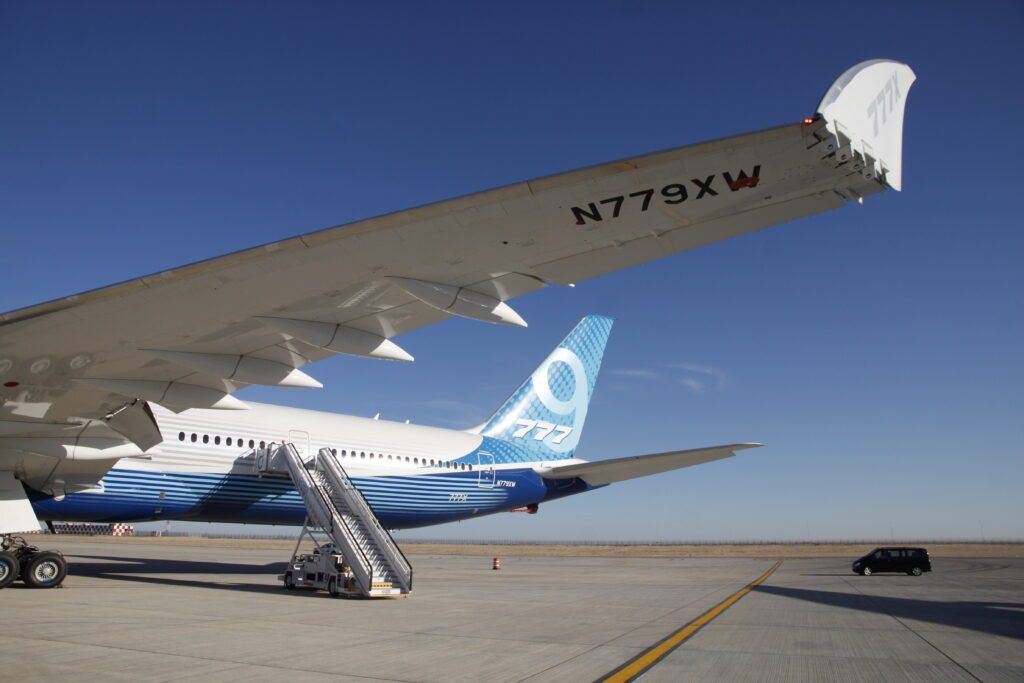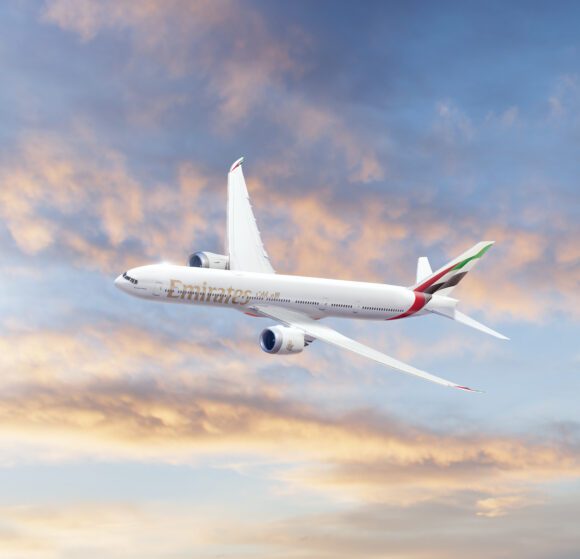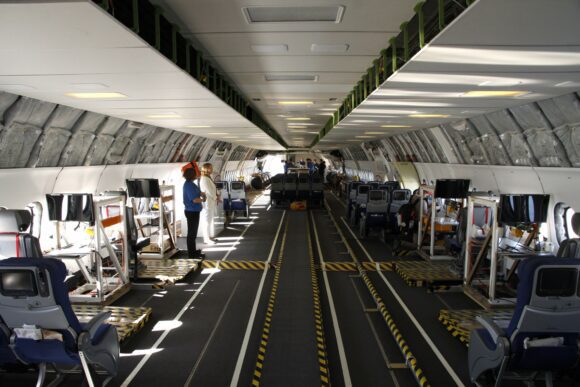
MG 9158 scaled
It must have felt like ten years ago on Monday when Emirates announced a follow-on order for 90 Boeing 777X aircraft. It is a decade since that famous 2013 Dubai Airshow, when Emirates, Qatar Airways, and Etihad ordered 225 of them. The first 777-9 will fly with paying passengers only in 2025, some six years later as certification issues have delayed the program. But Boeing is getting there. And despite the setbacks, the airframer is fully confident that the 777X has a healthy future in front of her.
AirInsight spoke on the first test aircraft on static display at Dubai Airshow with John Dyson, Head of Product Marketing of the 777X. A delay of ten years, changing travel patterns since the pandemic, and a strong recovery: has this changed the market outlook for large widebodies like the 777X?
Dyson thinks not: “Covid kept a lot of aircraft in the fleet that should have been retired. So there are a lot of the older fleet hanging around that we assume will be replaced. But this is the aircraft that will replace those older large widebodies with 350 or more seats.”
“We see this aircraft as the perfect ideal fit for that marketplace. There is over 1.700 777s flying out there today, A340s and 747s that it will need to replace, this is the only airplane that can replace them. The only thing that can replace a 777 is a 777.”
Market developments
So where exactly is the market for the 777X? “If we are looking at demand, we are looking at airports that are constrained in Europe or the US. Take Amsterdam, where they are reducing and removing permits. We see this being a trend that might continue in the future, which means you need more seats, more gauge, to get into those markets. The only way you get more seats now is a 777-9. 420 seats, 50 more than the competition. Or if you need more range, you take the 777-8 that will come around in 2030.”
John Dyson sounds very much like former Airbus sales chief John Leahy, who kept saying in the heydays of the A380 program that the aircraft would be a perfect fit for slot-constrained airports. Dyson sees the similarities, but points out a different situation with the 777X:
“The age of the four-engine aircraft is over. And it is over because the 777 came out. The 777 unfortunately did away with the 747 and also forced the A380 out of business. But they are not comparable programs. The A380 did I think 250+ sales in its history, we are already at 300+ with the 777X and we have a lot of momentum going forward.”
“We see that demand in the marketplace as large widebodies are aging. EIS of the 777-300ER was really 12-15 years ago, so we are seeing that first replacement demand coming into the market, although it is still a relatively young fleet. So the timing of the 777-9 with the delivery in 2025 kind of starts that bow wave of demand and replacement.”
Orders
Before the Dubai Airshow, Boeing had won 322 gross orders for the 777-9, 777-8, and 777-8F. The Emirates order for 55 777-9s and 35 -8s brings gross orders to 412 and net orders to 390 from 12 identified and some undisclosed customers. Emirates, Qatar Airways, Etihad, Lufthansa, Singapore Airlines, All Nippon Airways, British Airways, Silkway West, Cargolux, and Air India are on the customer list.
There is a similarity to the Airbus A380 program: the 777X has failed to win orders from US airlines. John Dyson thinks this is a question of time: “I would say US airlines were also late adopters of the 777-300ER. In the core market they are flying, the 787 fits in now. But if you look at emissions, NOx per seat, the lower noise going into places like London Heathrow or Amsterdam, you are going to need to have the per-seat advantage. There is no other airplane in the marketplace to deliver that than the 777-9 and -8.”
But where are the other potential customers? A few have selected the Airbus A350-1000 and are unlikely to add the 777X to the fleet, with Turkish Airlines like Air India probably one of the few airlines to have a look at both.
“We have a replacement cycle in Europe and Southeast Asia, South Asia a little bit as well, the Middle East. We see a lot of legacy 777 customers having demand and saying that the 777-300 is a pretty good airplane, there is no reason for them to have it replaced right now, but they will be ready for it in a few years’ time when the 777-9 is in service and is really flying around. We are excited about what the near-term shows for the program, but we are really excited about the long-term of the program. We have a decade, two decades to make this the flagship airplane for the market.”
The 777-8 is alive
Before the Emirates order for 35 777-8s, the passenger version of the type was seen to have an uncertain future, if any. Of the 43 gross orders, Boeing confirmed only eight in its net order backlog. The passenger -8 has been redesigned and is now the same length as the -8F, the full freighter that was launched in January 2022 by Qatar Airways. It can see 11 more passengers or 395.
“The 777-8 will be a fantastic airplane. It is going to have 8.700 nautical miles of range, it basically is a -300ER replacement. The -9 is really suited for the core airlines like Emirates, and Qatar Airways kind of markets where they need to move 400+ passengers into big airports. It is great for Southeast Asia and South Asia, 17-18 hours or range essentially with -300ER payloads. It is going to be a great airplane when it comes out.”
Waiting for TIA
Boeing has done over 1.100 flights and 3.200 flight hours with four 777-9 test aircraft. However, the type still has to be granted Type Inspection Authorization (TIA) by the FAA, which is the crucial and final phase of the test program that will eventually lead to certification. Boeing still counts on certification in late 2024/early 2025 and entry into service in 2025.
John Dyson: “We look at it from an airline attitude. We will have 2.000 hours on the flight test program and 4.000 cycles, which is more than we did on the entire certification of the 787. So this aircraft is very mature. We have done a lot of flight profiles that we expect to do in flight tests with the FAA. We also work a lot on the maintainability, bring the airlines in, working with them to get their feedback.”
“What we are talking about internally and to external customers about configuration stability. We want the aircraft to be configuration-stable so that what we are submitting to the FAA reflects what the aircraft is. That will help us to eventually get Type Inspection Certification. We are close, we can’t wait to see this aircraft with the FAA on board to start flight tests.”
Production restart
Visitors of the 777 line in Everett will see a lot more activity going on. Boeing is slowly restarting production of the 777-9. “We have section bodies of the forward fuselage section 41 in the factory right now and are getting ready to work on the 777X program in full. We are spooling up our composite wing production as well. It is like a big, kind of slow, complex dance that we have to do with the supply chain and our owned production facilities. You will see activity, not popping out fuselage right away, it is a few months before we will be at that point, but we are going there.”
Already, some 24 777-9s have been assembled since 2019, most of them for Emirates and a few for Lufthansa. These aircraft have been in storage since the production was paused in early 2022. These frames will require some rework before they rejoin the final assembly line.
“Certainly. As we are going through design changes as we go through flight tests and the final stages of the test program, we will have to rework those airplanes so they come back in the configuration compliance. We have a pretty good system in place to bring them back into compliance and delivery standards.”
It is most likely that at the next Dubai Airshow in 2025, the 777-9 will have entered service, and Emirates will have one on static display. The years lost in delays and problems will seem something of the distant past. John Dyson can’t wait to see the aircraft enter service.
“Certainly, if we could restart everything, we would have loved to have the airplane earlier. But we are where we are in terms of certification. That’s fine. We are giving it the time, the space, and transparency (to the regulators) to move at their pace and we are willing to demonstrate that this airplane will be incredibly safe and efficient for decades to come.”
Views: 21






